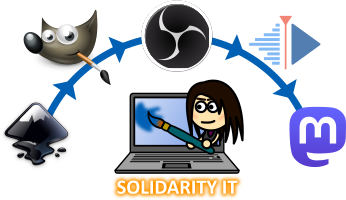What’s the Deal with Open-Source Alternatives?

Do You Make Use of Open-Source Software?
Open-source software is becoming increasingly popular, but what exactly does it mean? Open-source means that the original source code—the instructions that the software is compiled from—is freely available for anyone to view, edit, and create new versions. This decentralized approach to software development allows individuals, teams, and groups to work on their own versions, and integrate its features into the main software.
The Ethical Advantages of Open-Source Software
One of the most compelling reasons to use open-source software is its ethical foundation. Unlike commercial software, which is often driven by profit motives, open-source software is community-led and focused on collaboration and transparency. This means that the software is maintained and updated through the collective efforts of volunteers and contributors who are passionate about creating high-quality, accessible tools for everyone.
From a user’s perspective, the primary advantage of open-source software is that it is available for free. This community-driven approach ensures that the software evolves to meet the needs of its users, without the influence of profit-driven agendas. Additionally, open-source projects are typically supported through donations, which further emphasizes their nature as community support tools.
While the term “open-source” is most commonly associated with software, it can also apply to other things. For example, open-source hardware has publicly available specifications and designs, and there is even open-source cola with a publicly available recipe, avoiding all the ethical issues around financially supporting Coca-Cola or Pepsi as companies.
Many open-source software projects can achieve much of what their commercial counterparts do despite having lower budgets. Additionally, there are often portable versions available, which can be installed on a USB drive. This is particularly useful if you frequently use a computer that you cannot install software on, such as in a library, office, or school.
The Downsides of Open-Source Software
So, if it’s free, what’s the catch? Open-source software does have a few disadvantages, which can lead people to prefer commercial software. Some of these may include:
- Fewer Features: The latest features seen in commercial software may not be available in open-source software, especially when using software for professional purposes.
- Harder to Use: Open-source software is sometimes less user-friendly, both in initial setup and ongoing use.
- Fewer Support Resources: Open-source software doesn’t have the same level of support to aid users if something goes wrong, as fewer people are trained in its use.
Examples of Open-Source Software
You can find open-source software with any search engine or look on Open-source Alternative, a searchable resource for finding open-source software.
Here are some of our recommendations:
- For video editing: Kdenlive. Capable of handling multiple audio and video tracks, it lets you cut your footage as needed and has a variety of visual and audio effects and transitions.
- For video recording and streaming: OBS Studio. This has many options useful for streamers. You can manage multiple video and audio sources, display them together, or toggle between them as needed. The video stream can then be directed to any streaming platform or recorded.
- For image editing: GIMP, the GNU Image Manipulation Program. It has an array of useful tools for editing photos and other images.
- For vector image design: Inkscape. Vector graphics work by defining individual points on a grid rather than pixels, perfect for creating diagrams and anything that needs to scale well.
- For social media: Mastodon. This decentralized social media platform is designed to be independently hosted, putting more control in the hands of individual communities and hosts.
Summary
Overall, open-source software can provide excellent alternatives to commercial software. While there are some trade-offs, the benefits of financial savings, community support, and ethical considerations often outweigh the downsides. By exploring open-source options, you can find powerful tools that meet your needs without breaking the bank, all while supporting a more transparent and collaborative approach to software development.


Leave a Reply